

1. Introduction
In this page, we return to Genesis 1:1 in order to focus on yet another facet of this - apparently inexhaustible - source of wonder.
Numbers like 666 and 888 which appear as strings of the same digit repeated are known as repdigits. Clearly, when the number of digits in the repdigit is three there is a close visual correspondence with the cube of that digit - particularly when 'multiplied by' is represented by a stop ('.') - as in 6.6.6 (= 216) and 8.8.8 (= 512). So we ask, Have the Judeo-Christian Scriptures anything to say about cubes? Indeed they have, as we shall now consider!
It is widely understood that the innermost compartment of the tabernacle (Ex.26) - the 'holy of holies', so-called - took the form of a perfect cube, and the association of this geometrical form with the biblical concept of holiness is confirmed by a reading of 1Kings 6:20 and Revelation 21:16. So what - if anything - has the cube (second of the five solids identified by Plato as regular polyhedra) to contribute in respect of scriptural self-authentication? Genesis 1:1 offers two independent answers to this question, viz (1) the cubes (and their associated repdigits) which arise naturally from the geometries of this verse and, (2) those which obtain from letter-products associated with the verse divisions already noted.
2. Cubes that arise from the geometries
In numero-geometric terms, a cube is typically represented by a stack of unit cubes (which also function as counters). Such stacks may be arranged as an infinite sequence, thus:
1, 8, 27, 64,... (i.e. 1.1.1, 2.2.2, 3.3.3, 4.4.4,...)
Clearly, this is a sparse subset of the natural numbers. But it so happens that some of these cubes - though relatively few - are also square numbers, for example,
1, 64, 729, 4096,... (i.e. 1.1, 8.8, 27.27, 64.64,...)
In other words, the odds against a chance encounter with any of these, in any context, are extremely high. To come across two of these rare objects in the normal course of events is therefore exceptional. Yet a particular numero-geometric form of the Bible's first verse leads directly to a situation of this kind - one accompanied by many other compelling features.
It has been demonstrated [The Beginning of Wonders #5/#6] that the Hebrew of Genesis 1:1 - the Bible's first verse - has a numero-geometrical presence, both as a system of triangles and as a triangle centrally placed within a trapezium. Here are the facts:
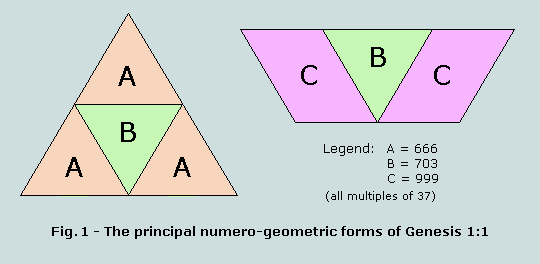
The second of these is particularly significant in the current context for it leads directly to the derivation of a third symmetrical form, as explained pictorially in Figure 2. Amazingly, word boundaries are not infringed in these constructs for B = 407 (word 6) + 296 (word 7), and C = 913 (word 1) + 86 (word 3) = 203 (word 2) + 401 (word 4) + 395 (word 5).
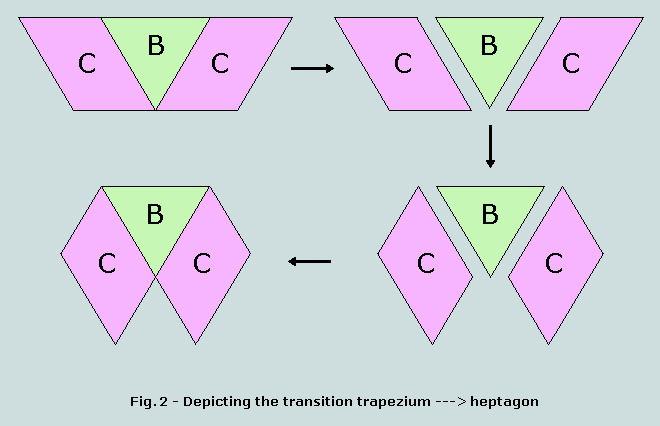
Further detail of this heptagon is provided here. As Figure 3 reveals, a logical development of this figure generates a rhombus (R) of side 64 - hence comprising 64.64, or 4096 counters. Observe that 4096 may also be written 16.16.16. In other words, it is both square and cube.
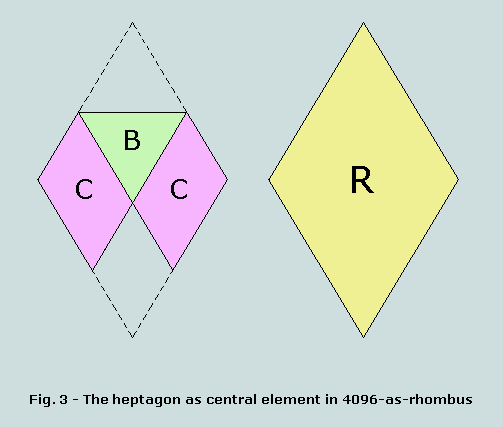
Following the placing of 2701-as-heptagon (representing the Bible's first verse) into this rhombus, the two empty spaces that remain are 666-as-triangle (A) and 729-as-rhombus (D), respectively (the latter representing another square and cube, i.e. 729 = 27.27 = 9.9.9).
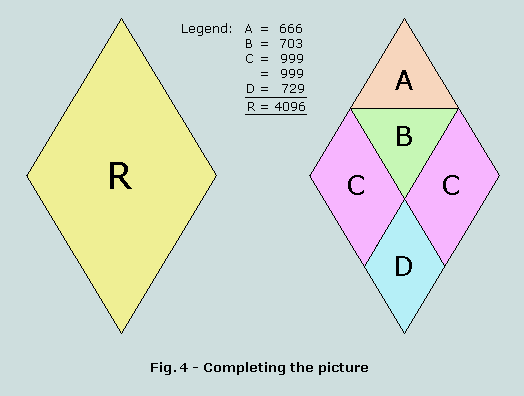
The significance of the appearances of both 666 and a further squares/cube - as depicted in Figures 4 and 5 - cannot be overstated.
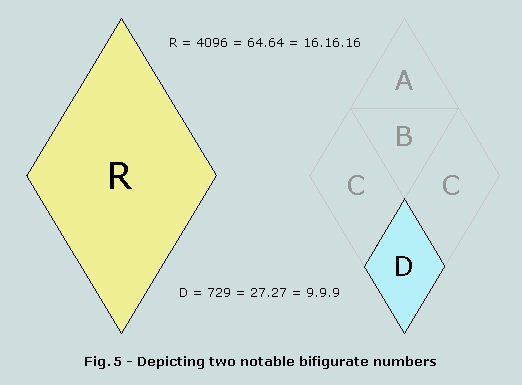
The complement of D, designated K, is the sum A + B + 2C. As Figure 6 makes clear, this represents the product of the trifigurate pair 37 and 91 - each involving the cubes of 3 and 4. Further, since this product is the difference of the two cubes, 4096 and 729, it may also be envisaged as a hollow cube.
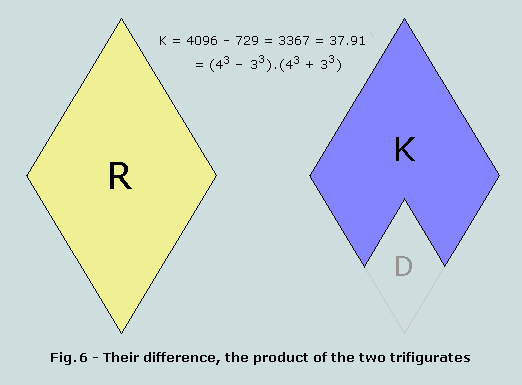
Interestingly, it may be observed that K takes the form of an arrowhead tipped with 666.
A different combination of areas yields yet another significant cube, thus:
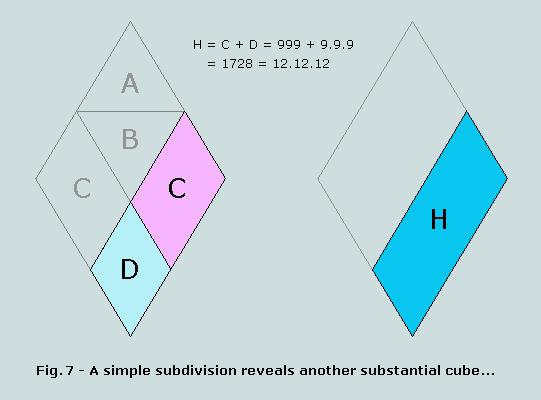
And its complement (another hollow cube), a big surprise!
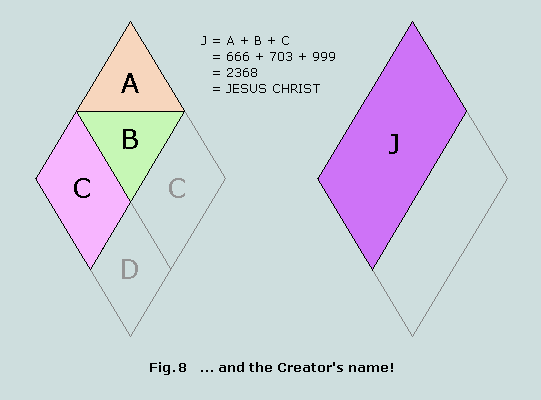
[At this point it is appropriate that we read a further extract from the Bible's final Book, Revelation, viz
"...and he (the Lord's angel) measured the (Holy) city...twelve thousand furlongs. The length and the breadth and the height of it are equal." (21:16)
Here we have the Lord's representative informing us that the holy Jerusalem has the form of a cube of dimension 12 units. The related symbolism of the foregoing figures is surely striking!]
The division of rhombus R (as represented in Figures 7 and 8) into 8 strips of width 8 uncovers further features of interest which are detailed in Figure 9.
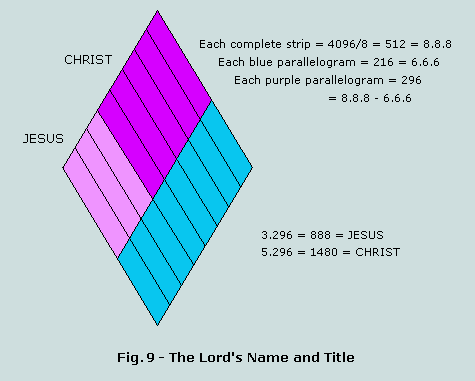
Observe that 296 - factor of both Name and Title of the Lord - is the numerical value of the 7th word of Genesis 1:1, translated "the earth" - and surely a most appropriate choice for the Incarnate One! Because it is also the difference of two cubes, it possesses the form of a hollow cube.
Examples of cube/repdigit relationships within the structure of 2701-as-heptagon include the following:
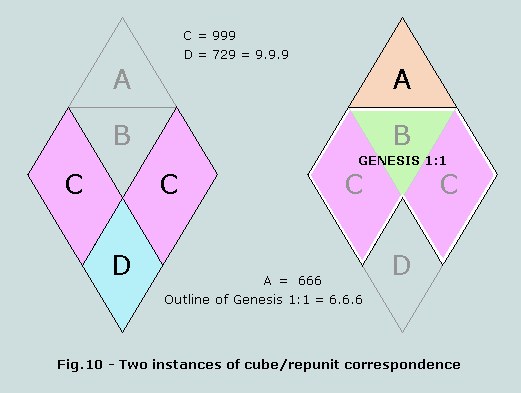
Read numerically, the first Hebrew word of the Judeo-Christian Scriptures is 913, i.e. 210 more than B, sum of words 6 and 7. Observing 210 to be a triangular number (and a rare example of one which is double that of another, viz 105) it becomes possible to represent 913 as a symmetrical object within the heptagon. This construction is detailed in Figure 11.
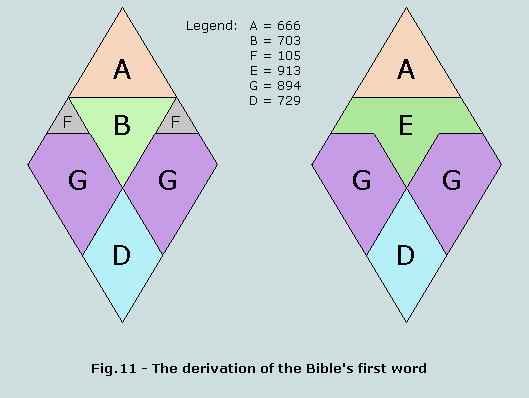
Remarkably, these manoeuvres uncover a further detail of interest, viz an even division of the remainder of the verse which, as before, does not infringe word boundaries. Thus, G = 203 (word 2) + 395 (word 5) + 296 (word 7) = 86 (word 3) + 401 (word 4) + 407 (word 6) = 894.
3. Cubes that arise from letter products
In the page The Arbiters of Truth the product of the 28 letters which constitute Genesis 1:1 was found to be a cube of side 288 billion. Details of the letter products of each of the seven words are detailed here, and summarized as follows:

Now observe,
The letter product of the first five words is also a cube, and is the first time that a cube appears at word boundaries:

Note that this is the cube of the letter products of the first word.
It follows that the letter product of the last two words must also be a cube:

and we observe that this is the cube of the product of the starting letters, Q.
In this way, the letter products suggest the division of Genesis 1:1 into first five words, and last two words, is intentional. And the importance of the first word, and the first letters of each of the seven words is made clear.
Vernon Jenkins MSc
2006.12.20
Acknowledgement: The author is indebted to Stephen Coneglan for drawing his attention to the letter product cubes.